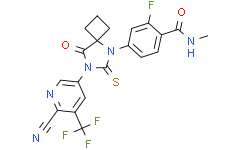| Description: |
Apalutamide (ARN-509) is a potent and competitive androgen receptor (AR) antagonist, binding AR with an IC50 of 16 nM. |
| Target: |
IC50: 16 nM (Androgen receptor)[1] |
| In Vivo: |
Apalutamide (ARN-509) exhibits low systemic clearance, high oral bioavailability and long plasma half-life in both mouse and dog, supporting once-daily oral dosing. Consistent with its long terminal-half-life, Apalutamide steady-state plasma-levels increases in repeat-dose studies, resulting in high C24hr levels and low peak:trough ratios (ratio:2.5). Castrate male mice bearing LNCaP/AR xenograft tumors are treated with either Apalutamide at doses of 1, 10 or 30 mg/kg/day. Thirteen of 20 Apalutamide (30 mg/kg/day)-treated animals exhibit >50% reduction in tumor-volume at day 28 versus 3 of 19 MDV3100 (30 mg/kg/day)-treated mice[1]. |
| In Vitro: |
Apalutamide (ARN-509) also exhibits low micromolar affinity (IC50 3 μM) for the GABAA receptor in radioligand binding-assays and thus may potentially antagonize GABAA at therapeutic dose levels[1]. Apalutamide is a potent androgen receptor (AR) antagonist that targets the AR ligand-binding domain and prevents AR nuclear translocation, DNA binding, and transcription of AR gene targets[2]. |
| Cell Assay: |
Trypsinized VCaP cells are adjusted to a concentration of 100,000 cells per mL in phenol-red-free RPMI 1640 (with 5% CSS), and dispensed in 16 µL aliquots into CellBIND 384 well plates. Cells are incubated for 48 hours, after which ligand is added in a 16 µL volume to the RPMI culture medium. For the antagonist mode assay, the ligands are diluted in culture medium also containing 30 pM R1881. After 7 days’ incubation, 16 µL of CellTiter-Glo Luminescent Cell Viability Assay is added and Relative Luminescence Units (RLUs) measured[1]. |
| Animal Administration: |
Mice[1] In vivo xenograft experiments to determine anti-tumor response are carried out in SHO SCID male mice. Mice are orchiectomized under isoflorane anesthesia and are given 2-3 days to recover prior to tumor cell injection. LNCaP/AR(cs) cells are suspended in 50% RPMI, 50% Matrigel, and 5×106 cells/xenograft are injected in a volume of 100 μL. Animals are observed weekly until tumor growth is apparent. From 24 d post-injection, tumors are measured weekly, and after 40-60 days post-injection, animals are randomized into cohorts of equivalent mean (150-250 mm3) and range tumor burden. All compounds (e.g., Apalutamide, 30 mg/kg per day) are administered daily by oral gavage. Statistical analyses are performed using Graphpad Prism. |
| References: |
[1]. Clegg NJ, et al. ARN-509: a novel antiandrogen for prostate cancer treatment. Cancer Res. 2012 Mar 15;72(6):1494-503.
[2]. Smith MR, et al. Phase 2 Study of the Safety and Antitumor Activity of Apalutamide (ARN-509), a Potent Androgen Receptor Antagonist, in the High-risk Nonmetastatic Castration-resistant Prostate Cancer Cohort. Eur Urol. 2016 May 6. pii: S0302-2838(16)30133 |






















